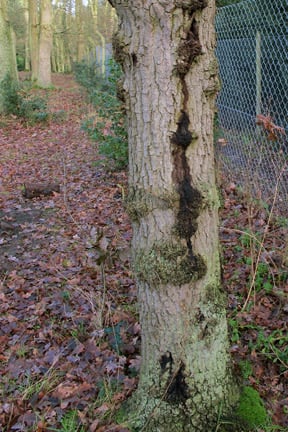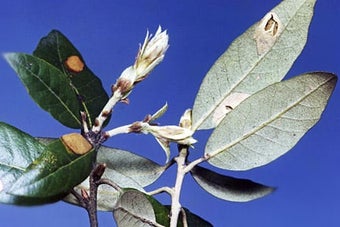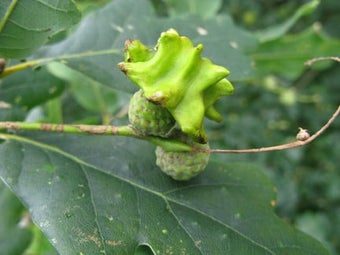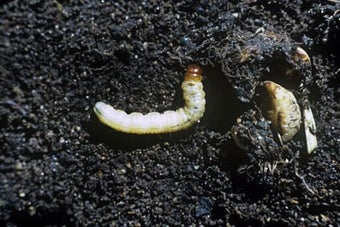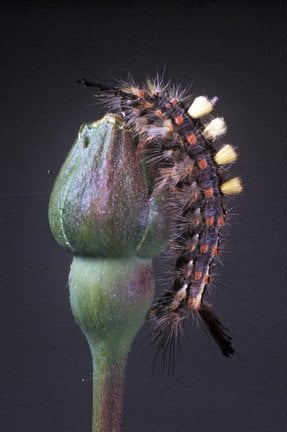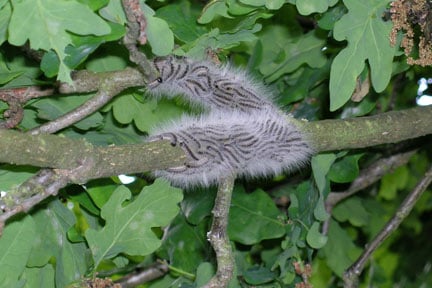
Quick facts
Common name - Oak Processionary moth
Scientific name - Thaumetopoea processionea
Plants affected - Quercus (oak)
Main symptoms - Dark caterpillars with white hairs, they move about in nose-to-tail processions. Silken webbing nests on the trunks and branches of oak trees can also be visible.
Most active - April-July
What is oak processionary moth?
The older caterpillars of the oak processionary moth are covered in irritant (urticating) hairs that can pose a health risk to humans and animals. The moth is not to Britain but has become established in London and the surrounding areas since it was first found in south west London in 2005. If the caterpillars are found they should be reported via TreeAlert. There are a number of species that are often mistaken for oak processionary moth, for more information on these see Forest Research information.
Adults moths are brown with a wingspan of 25-35 mm and are similar in appearance to several other moth species found in Britain. They emerge from pupae in mid to late summer and only live for a few days in which time they mate and lay eggs usually high up in oak trees. The moth overwinters as eggs. The eggs hatch in spring, between March and late April. The caterpillars usually initially feed high up in oak trees, and at this stage often go unnoticed.
By late spring to early summer the caterpillars become larger (20-25 mm) and are dark in colour covered with many white hairs. At this stage they become easily recognised as they have the distinctive habit of moving around in nose to tail processions, which give the species its name. The caterpillars also construct white webbing nests on trucks and branches of oak trees. At this time the caterpillars spend much of the day in the nests leaving in processions to feed at dawn and dusk.
When the nests and processions of caterpillars become visible it is at this stage that the irritant (urticating) hairs have developed which pose the potential of causing rashes and respiratory problems in humans and animals.
Symptoms
Whilst the caterpillars can defoliate parts of oak trees the most obvious signs of the presence of this moth are the dark hairy 25 mm long caterpillars which are present in late spring and early summer. They are easily recognised as they have moving around in nose to tail processions, these processions usually leave white silken trails behind.
In addition the caterpillars construct white webbing nests on trucks and branches of oak trees. The white silk often discolours brown. During late spring and early summer the caterpillars spend much of the day in the nests leaving in processions to feed at dawn and dusk, occasionally they will process between oak trees. The empty nests can remain present throughout the winter.

The problem
The caterpillars of oak processionary moth can defoliate oak trees however it is the irritant (urticating) hairs that have the potential to cause health problems to humans and animals. Read more: Forest Research public and animal health advice.
The moth is to southern Europe but has recently become more widespread in northern Europe. It appeared in South West London in 2005 and has since become widespread in the counties around London.
A Government surveillance programme has divided the UK into three areas (a map of them can be found here)
Established area (previously called Core zone) – London and surrounding areas where the moth is now well established.
Buffer zone – around the established area, where attempts are being made to slow the moth’s spread.
Pest free area (previously called Protected zone), which is divided to a 10 km zone from Pest Free Area and the area itself. In this area there is an extensive surveillance and program to monitor OPM. If the moth is found in that area robust actions will be taken for its eradication.
The Forestry Commission has produced an interactive distribution map of the oak processiony moth here.
There are now tough restrictions on importing oaks into the UK reducing the risk of the caterpillars being imported, find out more here.
Find out more control and containment programme co-ordinated by the Forestry Commission.
Management
Before reporting a suspected case of oak processionary moth please check the information from Forest Research, including a guide to species that are often mistaken for oak processionary moth:
- Oak processionary moth feeds almost exclusively on oak trees (Quercus)
- Oak processionary moth caterpillars can be distinguished by the distinctive habit of moving in nose-to-tail processions and clustering together, often in silken nests
- The nests are never woven in or on leaves but are always on the of oak trees. As empty nests can retain the irritating hairs these should also be reported
- Be aware that many other species of harmless moth caterpillar also produce webbing. In gardens these include the cotoneaster webber and small ermine moths
If you are still convinced they are indeed oak processionary moth caterpillars, what should you do?
- Do not approach or touch the caterpillars or nests
- Suspected cases should be reported via TreeAlert and where possible the landowner. If the landowner is aware that this moth is present in the location they may already have a strategy for its containment and control. Please follow any warning signs and safety information provided
- Due to the irritant hairs control of this insect should only be carried out by professional contractors. More information is available from the Forest Research


